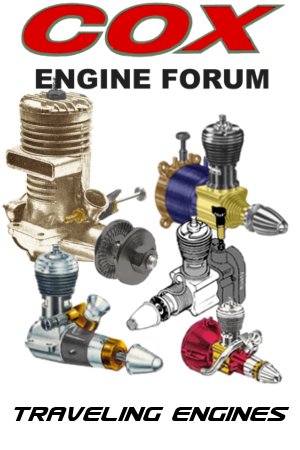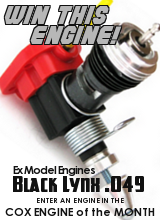Log in
Search
Latest topics
» Foam hand kids glider converted to 0.049 CLby roddie Today at 4:33 am
» Cox PT-19 Wing
by latole Today at 4:28 am
» Roddie-Rigger.. a 2005 original design
by roddie Today at 2:54 am
» Golden Bee basic running problem
by roddie Yesterday at 10:51 pm
» Simple Gliders
by rdw777 Yesterday at 6:25 pm
» Weird search for a single comic from an old Mad Magazine
by Kim Yesterday at 1:44 pm
» Scientific "Zipper" Build...Zipper Flys!.
by getback Yesterday at 7:27 am
» Cox .049 Tee Dee engines back in stock (limited availablility)
by GallopingGhostler Yesterday at 1:05 am
» Very off-topic.........Time passes and not always for the best......
by rsv1cox Thu Jul 25, 2024 2:47 pm
» Jim Walker Bonanza etc.
by rsv1cox Wed Jul 24, 2024 6:30 pm
» Throttles for Cox Tee Dee .049 / .020 / .010 engines --- videos
by sosam117 Wed Jul 24, 2024 8:54 am
» Introducing our Cox .049 TD Engines
by Admin Tue Jul 23, 2024 2:00 am
Cox Engine of The Month
July-2024
robot797's
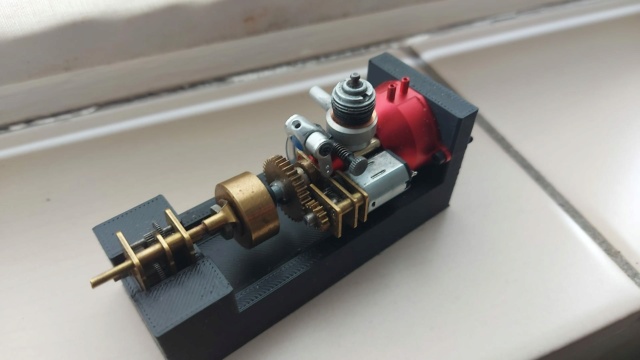
"ULTIMITE COX 010: it has a clutch, E starter, throttle, exhaust, aluminum tank, aluminum venturi, gearbox with forward and reverse, and now its on a custom drawn and printed stand"

PAST WINNERS
robot797's

"ULTIMITE COX 010: it has a clutch, E starter, throttle, exhaust, aluminum tank, aluminum venturi, gearbox with forward and reverse, and now its on a custom drawn and printed stand"

PAST WINNERS
Engine varnish development
Page 1 of 1
 Engine varnish development
Engine varnish development
With the humid weather arriving, I noticed that the 09 TeeDee engines with Kamtechnik turbo head and muffler tend to develop varnish on the cylinder wall faster than before, like in the dry summer season. It is true that the RC muffler adds to cylinder backpressure and maybe, throttles the exhaust gases such the the cylinder remains hotter than without the muffler, and the high compression Kamtechnik head also rises the combustion temperature.
The high combustion temperature boosts varnish deposition. I use 3 head gaskets, but may need to move towards 4, otherwise I may need to devarnish the cylinder after each 2nd or 3rd flight, to reduce the piston friction in the cylinder.
Especially now that I have replaced the less reliable stock plastic fuel nipple on the COX RC carb with a DIY metal nipple I made from re-purposed wheel stop, I do not assume that occasional air leak through the nipple lip would make the fuel lean, and the engine overheated - as often observed in consequence of e.g. worn NV threads. The small O-ring on the RC NV is also intact and seals well.
For de-varnishing I do not use any mechanical method like devarnisher brush, so as to prevent unwanted cylinder wear. Instead, I spray kitchen de-greaser agent into the cylinder, and rub it with an ear bud until no more brownish layer on the cylinder, and on the ear bud, remains....
Has anyone else met this frequent need for cylinder de-varnishing, and what cure proved the best to prevent, or delay it? I always use 60/20/20 full castor fuel, but do not face this problem with unmuffled COX engines, so at the end I think the muffler is the culprit.
The high combustion temperature boosts varnish deposition. I use 3 head gaskets, but may need to move towards 4, otherwise I may need to devarnish the cylinder after each 2nd or 3rd flight, to reduce the piston friction in the cylinder.
Especially now that I have replaced the less reliable stock plastic fuel nipple on the COX RC carb with a DIY metal nipple I made from re-purposed wheel stop, I do not assume that occasional air leak through the nipple lip would make the fuel lean, and the engine overheated - as often observed in consequence of e.g. worn NV threads. The small O-ring on the RC NV is also intact and seals well.
For de-varnishing I do not use any mechanical method like devarnisher brush, so as to prevent unwanted cylinder wear. Instead, I spray kitchen de-greaser agent into the cylinder, and rub it with an ear bud until no more brownish layer on the cylinder, and on the ear bud, remains....
Has anyone else met this frequent need for cylinder de-varnishing, and what cure proved the best to prevent, or delay it? I always use 60/20/20 full castor fuel, but do not face this problem with unmuffled COX engines, so at the end I think the muffler is the culprit.

balogh- Top Poster



Posts : 4803
Join date : 2011-11-06
Age : 65
Location : Budapest Hungary
 Re: Engine varnish development
Re: Engine varnish development
I use the Cox round mufflers on my engines 049 surestart and 049 TD. I use Kamtechnic heads and 3 head washers, fuel is 25,25,50 and the Castor is Castor M from Scotcher Race Fuels in Australia, actually the nitro and methanol is from there also and is the highest quality race fuel components as they supply most of the motor sport here. I use a 5 x 3 prop and a reasonably cold turbo plug. My engines are only used for CL so they are always running just back of lean and never really running with low revs. The TD cylinders are running timing gaskets to remove the SPI which I have found is awesome with the TD and a muffler and I certainly have no performance issues. Might the timing gaskets to remove the SPI be the difference?
I dont seem to get any build up on my cylinders and I have looked for it and I do know what Im looking for. I think the approach you take to removing it is a good one! I dont feel comfortable with the more mechanical means some use to remove varnish!!!
Is the fuel bought allready mixed? Is it possible to get some different Castor and try out. The Scotcher Race Fuel people tell me their Castor is de-gummed and prevents this. I have read much on this and quite frankly dont know what to believe in respect to de-gummed Castor. I have read all kinds of chemical arguments and basically it beyond my understanding and probably most peoples.
Does this happen on both new piston/cylinder pairs and old piston/cylinder pairs. Just wondering if an old piston/cylinder pair has enough little scratches and wear to provide a binding surface for the build up, just like inflamed arteries in people collect cholesterol and block. When you fly the planes are the flights long flights 10/15 minutes or short control line flights? Are the engines and exhaust well exposed to the air flow or in behind a cowling.
Maybe try three or so flights at full throttle and see if it still happens. I dont fly RC and dont have throttle control therefore.
Hope you can sort it out, this would be very fustrating!!!
Yabby
I dont seem to get any build up on my cylinders and I have looked for it and I do know what Im looking for. I think the approach you take to removing it is a good one! I dont feel comfortable with the more mechanical means some use to remove varnish!!!

Is the fuel bought allready mixed? Is it possible to get some different Castor and try out. The Scotcher Race Fuel people tell me their Castor is de-gummed and prevents this. I have read much on this and quite frankly dont know what to believe in respect to de-gummed Castor. I have read all kinds of chemical arguments and basically it beyond my understanding and probably most peoples.
Does this happen on both new piston/cylinder pairs and old piston/cylinder pairs. Just wondering if an old piston/cylinder pair has enough little scratches and wear to provide a binding surface for the build up, just like inflamed arteries in people collect cholesterol and block. When you fly the planes are the flights long flights 10/15 minutes or short control line flights? Are the engines and exhaust well exposed to the air flow or in behind a cowling.
Maybe try three or so flights at full throttle and see if it still happens. I dont fly RC and dont have throttle control therefore.
Hope you can sort it out, this would be very fustrating!!!
Yabby

Yabby- Platinum Member



Posts : 711
Join date : 2021-06-08
Location : Yorke Peninsula South Australia
 Re: Engine varnish development
Re: Engine varnish development
Thanks Yabby
On my part of the world fuels sold nowadays are blended almost exclusively with synt oil, so for my COX engines I must mix my own fuel to make sure it is castor based. I am not sure if the castor I buy is degummed or not.
The varnish build up is otherwise very rare in the engines that I fly exclusively in RC service, be it a TeeDee 010 or anything up to 051.
The 09 TeeDee RC acts somehow different, but its cylinder and muffler are well exposed to the air, so cooling should not be a problem I guess. Relatively new piston and cylinder combo with only a few hours runtime on it. Still good pinch at TDC, these are classic tapered old stock items...maybe it is the taper bore, combined with the Kamtechnik head and medium cold plug plus the muffler that makes it more susceptible to varnish build up by causing some overheating??
My flights are near 8 minutes long with 2oz fuel on board, the engine mainly running at full throttle.
I am thinking of removing the silicon exhaust extender to help better exhaust ventilaton, even though I was under the impression the slanted extension tip acts like a venturi and actually provides rather depression than overpressure in the muffler...unfortunately I have timing shims for 049 size cylinders only, so removing the SPI is not an option with the 09 cylinder.
On my part of the world fuels sold nowadays are blended almost exclusively with synt oil, so for my COX engines I must mix my own fuel to make sure it is castor based. I am not sure if the castor I buy is degummed or not.
The varnish build up is otherwise very rare in the engines that I fly exclusively in RC service, be it a TeeDee 010 or anything up to 051.
The 09 TeeDee RC acts somehow different, but its cylinder and muffler are well exposed to the air, so cooling should not be a problem I guess. Relatively new piston and cylinder combo with only a few hours runtime on it. Still good pinch at TDC, these are classic tapered old stock items...maybe it is the taper bore, combined with the Kamtechnik head and medium cold plug plus the muffler that makes it more susceptible to varnish build up by causing some overheating??
My flights are near 8 minutes long with 2oz fuel on board, the engine mainly running at full throttle.
I am thinking of removing the silicon exhaust extender to help better exhaust ventilaton, even though I was under the impression the slanted extension tip acts like a venturi and actually provides rather depression than overpressure in the muffler...unfortunately I have timing shims for 049 size cylinders only, so removing the SPI is not an option with the 09 cylinder.

balogh- Top Poster



Posts : 4803
Join date : 2011-11-06
Age : 65
Location : Budapest Hungary
 Re: Engine varnish development
Re: Engine varnish development
Wow, thats a really weird problem that it is happening on the 09 only in the main. I assume you use the same fuel in all of them, so that really eliminates the fuel issue. I personally think the de-gummed castor is one of those Cox model engine myths. Lol. maybe its true, I just dont know. :-) But if the same fuel in other engines doesnt cause the problem, I tend to think its not the fuel. I blend my own fuel also because it fast, easy, cheap (half the price), and I know exactly whats in it. Ive got a graduated (engraved) 1 litre pyrex container. Add 250 mls of Nitro, 250 mls of castor, 500 mls of methanol, pour into 1 litre suitable bottle, done! 

SPI with mufflers is a genuine problem as it sucks old oily fuel back in. But!!, SPI on race bikes with specifically designed pipes/chambers is a performance boost as they are designed to just sniff enough of the exhaust into the crankcase to preheat the mixture in the crankcase which helps it atomize, flow, basically goes bang better! :-) But, in general having SPI with a muffler not designed for the purpose is not a very good thing. Would it cause the problem you are seeing? I honestly dont know.
If you ran the engine statically without flying in a test bench does it happen when you do that? Are you able to remove the exhaust extension in a test bench situation and see what happens, and then remove the muffler completely if necessary and see what happens.
I assume the castor is turning into varnish due to heat...? One of the things castor does and does do very well is carry heat away from the engine as it is expelled out the exhaust.
I have found I need extra gaskets with the Kamtechnic heads, which I use on most of my engines. I guess one change you could make would be to try a standard cox glow head and see what happens. Again you could do this on the bench if you live in an area where that sort of thing is ok. You would think if you have several hours on an engine, then its not the engine being too new.
A very out of the box thought. Is the crank plenty free and not too tight. A slightly tight crank will certainly produce a very lot of heat. Tight engine parts make more heat than the bang part. :-) Which is what I think you were getting at about the older tapered bore. But you wouldn't think that would cause the problem, especially after several hours of running.
Really interesting problem!, but Im sure very frustrating and annoying to you!
The only thing I can suggest and the way I would trouble shoot it is to do the following one at a time on a test bench to try and reproduce it and then fix it:
1. run the engine on a test bench with same fuel, muffler, glow, time period, etc. multiple times to make sure it can be reproduced on test bench. If you cant reproduce it on the test bench then its something to do with when its in the plane and airborne, which would be very bad for resolving it.
2. check the crank is not too tight, if you change it by putting drive plate back on with more end play, test as above again.
3. Remove the entire muffler system and see if you can reproduce it.
4. use a standard Cox glow plug
5. use a non tapered piston/cylinder combo
I very recently had a problem with a surestart 049 I newly assembled myself, and it would always get really hot and sag in revs and stop running if I tried to make it run anywhere near normal revs. Turned out that the standard Cox plugs using brand new gaskets would not seal when you screwed them in. I tried three brand new Cox plus and new gaskets. Still happened. I could turn the engine over by hand and see little bubbles between the cylinder and head. Put a Kamtechnic head on it and the entire problem went away. The head sealed properly, the engine didnt get as hot and ran fantastically.
Be very interested to hear if you are able to resolve the cause and what you find it to be.
Nice video and nice plane. One day I might try RC myself with Cox engines.


I hope I havent broken any rules by rambling on too much
Yabby
SPI with mufflers is a genuine problem as it sucks old oily fuel back in. But!!, SPI on race bikes with specifically designed pipes/chambers is a performance boost as they are designed to just sniff enough of the exhaust into the crankcase to preheat the mixture in the crankcase which helps it atomize, flow, basically goes bang better! :-) But, in general having SPI with a muffler not designed for the purpose is not a very good thing. Would it cause the problem you are seeing? I honestly dont know.
If you ran the engine statically without flying in a test bench does it happen when you do that? Are you able to remove the exhaust extension in a test bench situation and see what happens, and then remove the muffler completely if necessary and see what happens.
I assume the castor is turning into varnish due to heat...? One of the things castor does and does do very well is carry heat away from the engine as it is expelled out the exhaust.
I have found I need extra gaskets with the Kamtechnic heads, which I use on most of my engines. I guess one change you could make would be to try a standard cox glow head and see what happens. Again you could do this on the bench if you live in an area where that sort of thing is ok. You would think if you have several hours on an engine, then its not the engine being too new.
A very out of the box thought. Is the crank plenty free and not too tight. A slightly tight crank will certainly produce a very lot of heat. Tight engine parts make more heat than the bang part. :-) Which is what I think you were getting at about the older tapered bore. But you wouldn't think that would cause the problem, especially after several hours of running.
Really interesting problem!, but Im sure very frustrating and annoying to you!

The only thing I can suggest and the way I would trouble shoot it is to do the following one at a time on a test bench to try and reproduce it and then fix it:
1. run the engine on a test bench with same fuel, muffler, glow, time period, etc. multiple times to make sure it can be reproduced on test bench. If you cant reproduce it on the test bench then its something to do with when its in the plane and airborne, which would be very bad for resolving it.
2. check the crank is not too tight, if you change it by putting drive plate back on with more end play, test as above again.
3. Remove the entire muffler system and see if you can reproduce it.
4. use a standard Cox glow plug
5. use a non tapered piston/cylinder combo
I very recently had a problem with a surestart 049 I newly assembled myself, and it would always get really hot and sag in revs and stop running if I tried to make it run anywhere near normal revs. Turned out that the standard Cox plugs using brand new gaskets would not seal when you screwed them in. I tried three brand new Cox plus and new gaskets. Still happened. I could turn the engine over by hand and see little bubbles between the cylinder and head. Put a Kamtechnic head on it and the entire problem went away. The head sealed properly, the engine didnt get as hot and ran fantastically.
Be very interested to hear if you are able to resolve the cause and what you find it to be.
Nice video and nice plane. One day I might try RC myself with Cox engines.
I hope I havent broken any rules by rambling on too much
Yabby

Yabby- Platinum Member



Posts : 711
Join date : 2021-06-08
Location : Yorke Peninsula South Australia
 Re: Engine varnish development
Re: Engine varnish development
Thanks Yabby for the great advice, I will check the engine on the bench with and without the muffler, and with COX stock 09 head, to see what differences emerge compared to the current setup with Kamtechnik, muffler etc. I do not have un-tapered 09 cylinder though, and it is better to complete the experiment with the actual, tapered cylinder on the engine, because i will keep it for the everyday use .
The engine is otherwise quite healthy with no crankshaft issues like tight or loose fit. The cross hatches of honing still visible on the cylinder wall..
P.S.: There are no rules here that I would know of, restricting the length of very useful posts, so please feel free to share your IC engine experience with the team here.. If there were some rules like that, I would have been banned already with my sometimes lengthy entries where my didactic explanation is to balance and add clarity to my Hunglish
The engine is otherwise quite healthy with no crankshaft issues like tight or loose fit. The cross hatches of honing still visible on the cylinder wall..
P.S.: There are no rules here that I would know of, restricting the length of very useful posts, so please feel free to share your IC engine experience with the team here.. If there were some rules like that, I would have been banned already with my sometimes lengthy entries where my didactic explanation is to balance and add clarity to my Hunglish

balogh- Top Poster



Posts : 4803
Join date : 2011-11-06
Age : 65
Location : Budapest Hungary
 Similar topics
Similar topics» Varnish seize?
» Micro 12VDC Generator with a Cox .049 Sure Start Diesel Engine
» Too bad development didn't continue...
» Getting Rid of 'Old Man Varnish'
» paint and varnish
» Micro 12VDC Generator with a Cox .049 Sure Start Diesel Engine
» Too bad development didn't continue...
» Getting Rid of 'Old Man Varnish'
» paint and varnish
Page 1 of 1
Permissions in this forum:
You cannot reply to topics in this forum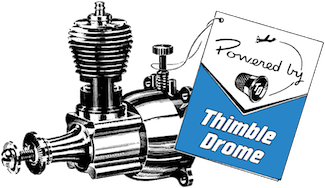
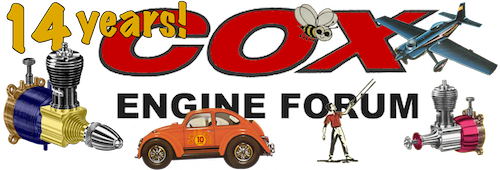
 Rules
Rules
